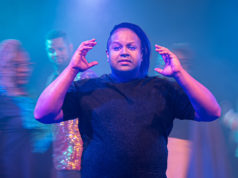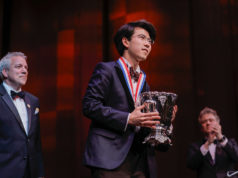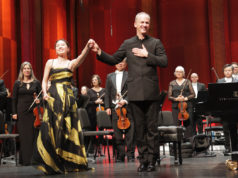There probably isn’t a better way to open a dance season than with a lavish production of Sleeping Beauty with choreography by Ben Stevenson, sets and costumes by Broadway designer Desmond Heeley, and a Tchaikovsky score that’s second to none. Texas Ballet Theater used the formula last weekend in Bass Performance Hall and earned an extra feather for its cap. There were blips, to be sure, but overall it was great theater. (Opening night sold out, and the other performances were close to it.)
Saturday night’s performance featured Carolyn Judson as Princess Aurora, her radiant smile and delicate technique great pluses here. She handled the balancing trials of Act II’s Rose Adagio with assurance, no wobbling or miscues as she stood on pointe arabesque, her arms forming a halo around her head. As each of the four suitors presented a rose, she lowered a hand to receive it, raising it again after each encounter still balanced on pointe –– one of the most punishing sequences in the ballet repertory.
Judson was equally impressive in the solo variation that followed, her gentle, flowing movements wonderfully reflecting Tchaikovsky’s lyrical music. She had the same success in the final pas de deux with her prince. This may be her best classical role.
The prince was newcomer Jiyan Dai, a tall, long-legged Chinese dancer making his TBT debut. A graduate of the Beijing Dance Academy, Dai won several Asian dance awards before joining the Universal Dance Company of South Korea in 2009. Two years ago he signed with the Tulsa Ballet and earlier this year joined TBT.
Technically strong, he brought cheers from the crowd with a series of running leaps. He did equally well with turns and jumps, although his one-foot landings need work. The leg raised behind tended to sag. Dai’s main drawback, though, was his acting, which showed little personality. He went through the motions and told the story, but there wasn’t much depth to the portrayal. It may be youth or just plain nerves, but it made for a somewhat bland performance.
Betsy McBride, on the other hand, was an engaging Lilac Fairy, a pivotal role that saved the day as she changed the death curse that the evil Carabosse cast on the infant Aurora to a long sleep, from which she could be awakened only by a prince’s kiss. Years later the fairy conjures up Aurora’s spirit for Prince Florimund to dance and fall in love with (at least in this version) and then guides him to Aurora’s resting place for the fateful kiss. Robin Bangert was a striking Carabosse, unleashing the fury of a woman scorned on everyone as she crashed the christening party uninvited, accompanied by smoke, fireworks, and four grimy-looking little attendants.
With an extended prologue and three acts, Sleeping Beauty abounds in specialty dances and divertissements. Frequently exaggerated to the point of caricature, the duet between Puss in Boots (Riley Moyano) and the White Cat (Diana Peters) was charmingly low key. As Moyano timidly made passes, Peters gently but firmly turned him away. They playfully fought and made up in a wonderfully sensitive performance.
But Adam Boreland as the Bluebird and his partner, Alexandra Farber, were in a league of their own. Boreland has incredible buoyancy in his jumps and lands like a feather. Everything seems effortless. None of the choreographic difficulties posed any challenge. Farber was just as nimble, and together they brought down the house. The two are listed in the program as members of the TBT corps. Surely, after performances like these, they might be considered for soloist status.
Supporting the dancers in the pit was the Fort Worth Symphony Orchestra led by guest conductor Michael Moricz, who also conducted the orchestra in TBT’s Swan Lake last spring. Sleeping Beauty and Swan Lake are arguably the most beautiful ballet scores we have, and the FWSO did a great job in bringing the music to life. Of special note this weekend was the harp playing of Jill Levy — a smooth, full-bodied account of a unique part in the harp repertory.
Unfortunately, the orchestra won’t be back for TBT’s Nutcracker runs in Fort Worth and Dallas in December. The budget still can’t handle a full season with live music. However, the FWSO will return in February to accompany the local premiere of Stevenson’s dance version of the popular operetta The Merry Widow.













The ballet here is very good, and well worth supporting.